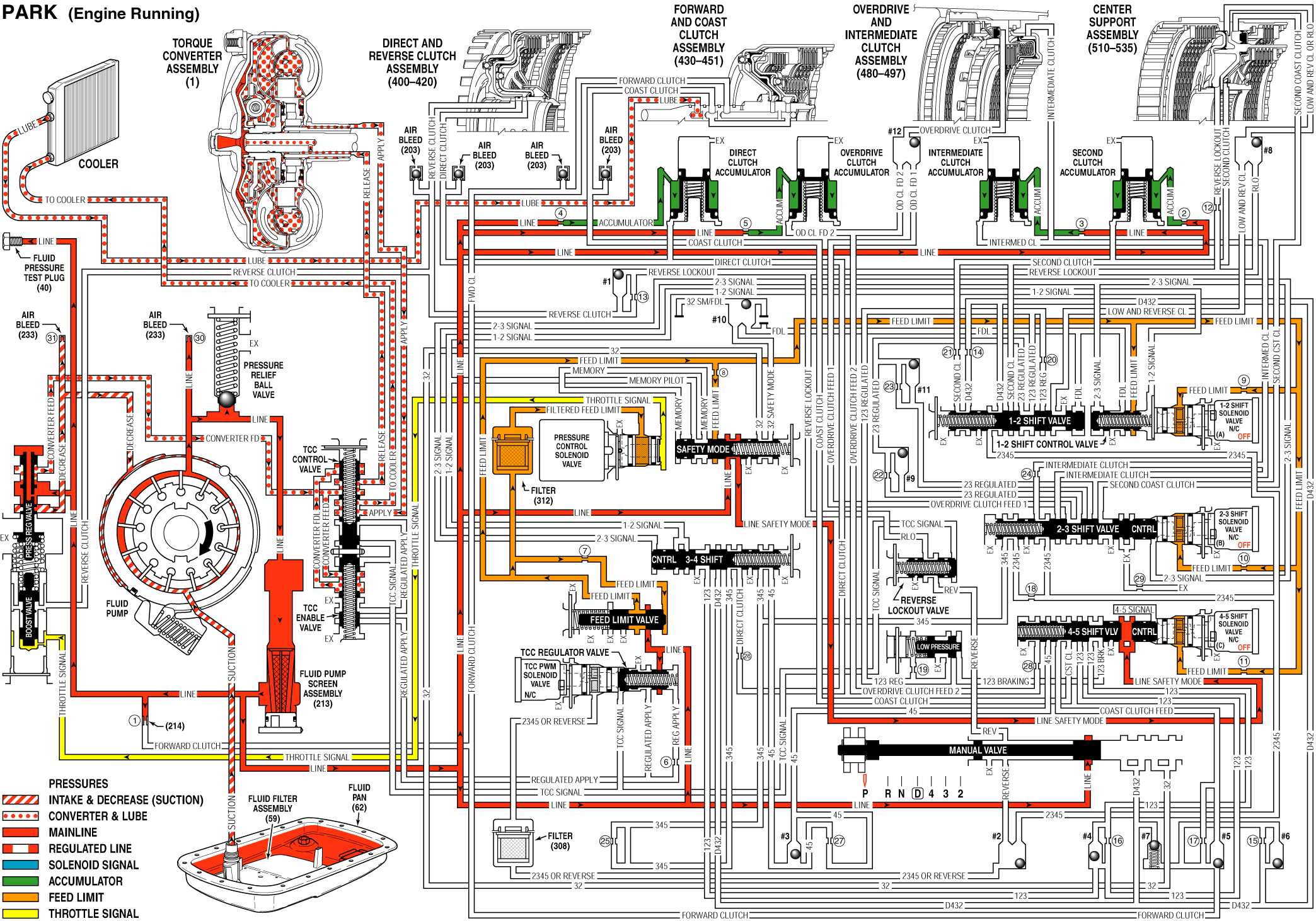Pressure Modulate
When the shift lever is in PARK (P) with the engine running, the fluid flow to oil pump and the line pressure is delivered to pressure regulator valve.
Pressure Modulator Valve: Regulate the oil pump output line pressure according to the throttle signal fluid pressure and spring tension on Line Boost Valve, and the line pressure on the end of the valve. The line pressure is delivered to the manual valve, the TCC regulator apply valve, the feed limit valve and the safety mode valve. The line pressure is also delivered to the converter feed lines and the accumulator fluid circuits via pressure modulator valve.
Feed limit valve: The line pressure is delivered to the feed limit fluid circuits via the valve. The valve can limit the pressure of feed limit fluid to less than the maximum pressure. The feed limit fluid is delivered to the PC solenoid valve, the safety mode valve and 1-2 control valve, and also feed to 1-2 signal, 2-3 signal and 4-5 signal fluid circuits.
Pressure Control (PC) Solenoid: The PC solenoid is controlled by TCM, which is used to regulate the pressure of filtered feed limit fluid, and the pressure is delivered to throttle signal fluid circuits.
Shift Accumulator
Direct, Overdrive, Intermediate and 2nd Gear Clutch Accumulator Assembly: Accumulator fluid is delivered to each accumulator assembly to be ready to upshift and downshift.
Torque Converter - only Off
Pressure modulator valve: The line pressure is delivered to converter feed lines by pressure modulator valve. Converter feed fluid is delivered to the TCC control valve and the TCC enable valve.
TCC regulator Valve: Spring tension hold the valve in Off position to prevent the line pressure from being delivered to the regulator apply fluid circuits.
TCC enable valve: The torque converter feed fluid is delivered to torque converter feed lines via TCC enable valve. The torque converter feed fluid flows to the TCC control valve.
TCC control valve: The spring tension holds the valve in Off position, then the torque converter feed fluid flows to the released fluid circuits.
Torque Converter: Released fluid pressure is delivered to torque converter to maintain the TCC released. Fluid flows out of the torque converter through the apply fluid circuits, and back to the cooler via the TCC control valve.
Safety Mode
Safety Mode Valve: 1-2 shift at the first time, the safety mode valve is switched from released to the applied position and remains constant until the engine is OFF. If the safety mode is ON - No TCM signal is sent to the shift solenoid, the transmission will shift to safety position - the 5th gear. If then turn the engine off and on, there is still no TCM signal, the safety mode valve will return to the released position and remain constant. Line pressure flows to line safety mode fluid circuits through safety mode valve. Line safety mode fluid flows to 4-5 shift valve mechanism.
4-5 Shift Valve and 4-5 Shift Control Valve: Line safety mode fluid make 4-5 shift valve downshift to 4 gear, under the safety mode with the engine off, it allows to start the 4th gear instead of the 5th.
Fluid Pressure Directed in Preparation for a Shift
Manual Valve: Mechanically controlled by the shift lever, the manual valve is in PARK (P) position and prevents line pressure from the pressure regulator valve from entering the reverse, D432 and 32 fluid circuits.
1-2 SS Valve and 1-2 Shift Control Valve: The feed limit fluid flows to 1-2 SS valve and 1-2 shift control valve from the feed limit valve to be ready to shift.
2-3 SS Valve: The feed limit fluid flows to 2-3 SS valve from the feed limit valve to be ready to shift.
4-5 SS Valve: The feed limit fluid flows to 4-5 SS valve from the feed limit valve to be ready to shift.
Direct Clutch, Overdrive Clutch, Intermediate Clutch and 2nd Gear Clutch Accumulator: Add the fluid to accumulator fluid circuits and accumulator assembly to be ready to upshift.
Park - Engine Running

